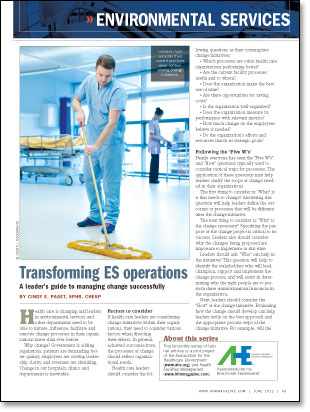 Health care is changing and leaders in environmental services and other departments need to be able to initiate, influence, facilitate and execute change processes in their organizations faster than ever before.
Health care is changing and leaders in environmental services and other departments need to be able to initiate, influence, facilitate and execute change processes in their organizations faster than ever before.
Why change? Government is adding regulations, patients are demanding better quality, employees are craving leadership clarity, and revenues are shrinking. Change in our hospitals, clinics and departments is inevitable.
Factors to consider
If health care leaders are considering change initiatives within their organizations, they need to consider various factors when directing their efforts. In general, achieved outcomes from the processes of change should reflect organizational needs.
Health care leaders should consider the following questions as they contemplate change initiatives:
- Which processes are other health care organizations performing better?
- Are the current facility processes useful and to whom?
- Does the organization make the best use of time?
- Are there opportuÂnities for saving costs?
- Is the organization well-organized?
- Does the organization measure its performance with relevant metrics?
- How much change do the employees believe is needed?
- Do the organization's efforts and resources match its strategic goals?
Following the 'Five W's'
Nearly everyone has seen the "Five W's" and "How" questions typically used to consider tactical steps for processes. The application of these questions may help leaders clarify the scope of change needed in their organizations.
The first thing to consider is: "What" is it that needs to change? Answering this question will help leaders define the outcomes or processes that will be different after the change initiative.
The next thing to consider is: "Why" is the change necessary? Specifying the purpose of the change project is critical to its success. Leaders also should consider why the changes being proposed are important to implement at this time.
Leaders should ask: "Who" can help in the initiative? This question will help to identify the stakeholders who will lead, champion, support and implement the change process, and will assist in determining who the right people are to perform these transformational functions in the organization.
Next, leaders should consider the "How" of the change initiative. Evaluating how the change should develop can help leaders settle on the best approach and the appropriate process steps of the change initiative. For example, will the organization use a phased approach or a big blast approach? Will it use external resources or engage internal champions to lead the change initiative?
Identifying "When" to change will facilitate the creation of a timeline for the process. A key question to consider is whether the change process will take place over a few months or will require a few years to fully implement.
Finally, leaders should ask "Where" the change should occur. The answer to this question assists in structuring the scope of the change process and assessing whether the change impacts the entire facility or just a department.
About the '10 P's'
Successful change initiatives undergo a series of well-defined and established processes before, during and after the change. These processes called the "10 P's" are defined as follows:
Perception. Creating the vision or word picture of the new environment after the change involves a discussion of the current state of the department in terms of outcomes and desired future outcomes. This should offer stakeholders inspiration and motivation toward change. The vision must be shared among stakeholders to succeed.
Path. This involves the methods and pathways that will be used to complete the change process. Some organizations use consultants, vendor tools or online educational materials to assist with change implementation processes and planning.
People. This concerns the stakeholders or interested parties who will be impacted by the change process and implementation. These may include community members, physicians, staff and patients. Selection of the change implementation team should include those who model effective leadership characteristics, are effective communicators and have access to stakeholder audience members.
Pace. This covers the gait and timeline for the change implementation process from the point of visioneering to performance and progress. The pace will influence stakeholder ideas and input as well as the overall decision-making process. A fast pace and short timeline may leave stakeholders feeling that they have not had enough time to process the changes, provide their input or properly prepare for the change implementation. A timeline that is too slow may reduce enthusiasm, create project boredom or result in loss of leaders to other, more vibrant projects.
Preparations. This involves the design of the change process which may include stakeholder discussions, research into vendor products, evaluations of alternatives, stakeholder decisions and project mapping plans. This stage of the process should include impact statements, communication proposals, decision-making models, vendor proposals and stakeholder options.
Provisions. The acquisition of supplies and materials can be critical to the success of any change implementation process. Modifications to buildings, supply orders, equipment, information technology, phone systems, work stations, security and communication systems will require advance notice and planning for a smooth change process. The human resources department also may need to hire or reduce staffing, expand or contract job descriptions and change recognition systems before the change process can be implemented.
Practice. Testing or piloting large-scale change in smaller test groups often can identify glitches or problems that were unanticipated. Opportunities to evaluate the change process and obtain stakeholder feedback can be invaluable for large-scale change projects.
Performance. Once piloting has been completed and appropriate adjustments made, the change project is ready for the implementation or performance stage. Often this stage is termed the "go-live" or "implementation" date. The selection of the go-live date should be made with consideration to regular calendar tasks such as time card day, payroll day, end-of-month reports, budget preparation days, holidays, high census or discharge days.
Perseverance. The perseverance phase involves maintaining the change initiative when stakeholders begin to desire returning to the way it always has been. This phase is the most challenging because it requires attention long after the implementation date. The natural response to change is discomfort so the post-implementation response left unchecked will be for the organization or department to return to pre-change norms. This phase will require a continual presence of the change purpose, vision, encouragement and impact of successful change long term. Leaders who are skilled in assessment, watching for signs of post-change U-turns and addressing the signs quickly, will be the most successful in persevering in the long run.
Perfection. At this stage, the change process has been in place long enough to have changed the cultural norms and behaviors within the group, team, department or organization. Monitoring metrics over an appropriate period with successful outcomes will determine the state of perfection or the completion of the change-initiative process.
Post-change follow-up
Post-change actions are an important component to any change initiative. Although the tendency may be to omit this component, care should be taken to include these actions:
Evaluation. Typically this process includes a "What went well?" vs. "What could be better?" analysis by the implementation team and the stakeholder group. The most common theme of the what could be better analysis is more communication because the change leaders often are more easily able to conceptualize the vision than the impacted stakeholders. Facilitation of this discussion will require conversational safety - the freedom to speak openly, trust of change leaders by stakeholders, and adequate time for listening and sharing of the change experience.
Acknowledgment. Recognizing key stakeholders and leaders of the change implementation team is important for helping them feel valued for their extra work, typically in addition to their regular jobs. This acknowledgment should highlight the particular talents and strengths these key players demonstrated during the change project to assist the organization with the successful outcome.
Celebration. This is the time when all participants, including all stakeholders, should be recognized for achieving a successful change effort and new process, service or initiative. Critical to future change initiatives is recognition of the challenges of change in the workplace among team members who are diverse or may communicate in different ways, but who ultimately have come together for this change initiative and betterment of the organization. There is pain in change and people want to be recognized for their sacrifices in terms of changing their routines and their work processes.
Changing for success
Change processes are necessary for organizational success and business growth in today's competitive health care market. Patients are much savvier regarding health care provider ratings, hospital performance scores and patient advocate avenues. Increasingly, patients are selecting providers and health care facilities based on published quality data, customer service and price.
Health care organizations and leaders who are competent in change leadership are equipped to embrace new governmental regulations, required community care programs, health care technology and changing reimbursement systems.
Relationships among health care providers and team members also will evolve along with changing outcomes and processes so the most competent change leader will have the advantage in today's health care environment.
Determining the reasons for changing an organization, answering the questions of change and practicing the 10 P's of the change process will enable health care leaders to complete their change project successfully.
Cindy E. Paget, SPHR, CHESP, is the principal of Leader-Works, a leadership renewal and development company; human resource manager for St Luke's Health System; a health care consultant for HireCare HealthCare Professional Services; and a certified solutions specialist for Environmental Service Consultants. She also serves on the Association for the Healthcare Environment advisory, planning, and education committees, and as an online facilitator for AHE leadership development courses. She can be reached at cindy@leader-works.com.
| Sidebar - To learn more on change management |
| There are many helpful books available on organizational change management. The author of this article recommends the following references to health care leaders.
|





